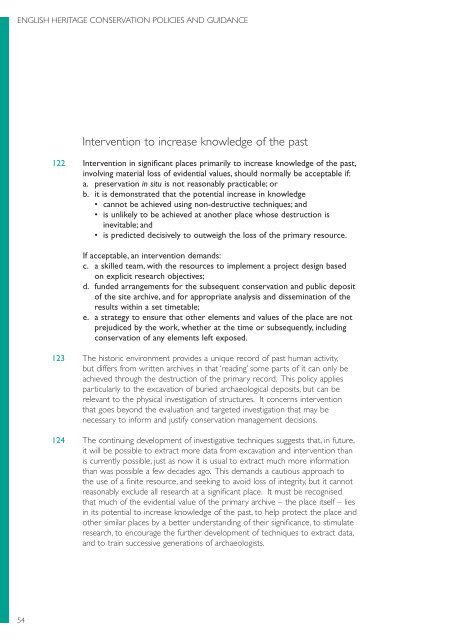Conservation Principles, Policies and Guidance - English Heritage
Conservation Principles, Policies and Guidance - English Heritage
Conservation Principles, Policies and Guidance - English Heritage
Create successful ePaper yourself
Turn your PDF publications into a flip-book with our unique Google optimized e-Paper software.
ENGLISH HERITAGE CONSERVATION POLICIES AND GUIDANCE<br />
54<br />
Intervention to increase knowledge of the past<br />
122 Intervention in significant places primarily to increase knowledge of the past,<br />
involving material loss of evidential values, should normally be acceptable if:<br />
a. preservation in situ is not reasonably practicable; or<br />
b. it is demonstrated that the potential increase in knowledge<br />
• cannot be achieved using non-destructive techniques; <strong>and</strong><br />
• is unlikely to be achieved at another place whose destruction is<br />
inevitable; <strong>and</strong><br />
• is predicted decisively to outweigh the loss of the primary resource.<br />
If acceptable, an intervention dem<strong>and</strong>s:<br />
c. a skilled team, with the resources to implement a project design based<br />
on explicit research objectives;<br />
d. funded arrangements for the subsequent conservation <strong>and</strong> public deposit<br />
of the site archive, <strong>and</strong> for appropriate analysis <strong>and</strong> dissemination of the<br />
results within a set timetable;<br />
e. a strategy to ensure that other elements <strong>and</strong> values of the place are not<br />
prejudiced by the work, whether at the time or subsequently, including<br />
conservation of any elements left exposed.<br />
123 The historic environment provides a unique record of past human activity,<br />
but differs from written archives in that ‘reading’ some parts of it can only be<br />
achieved through the destruction of the primary record. This policy applies<br />
particularly to the excavation of buried archaeological deposits, but can be<br />
relevant to the physical investigation of structures. It concerns intervention<br />
that goes beyond the evaluation <strong>and</strong> targeted investigation that may be<br />
necessary to inform <strong>and</strong> justify conservation management decisions.<br />
124 The continuing development of investigative techniques suggests that, in future,<br />
it will be possible to extract more data from excavation <strong>and</strong> intervention than<br />
is currently possible, just as now it is usual to extract much more information<br />
than was possible a few decades ago. This dem<strong>and</strong>s a cautious approach to<br />
the use of a finite resource, <strong>and</strong> seeking to avoid loss of integrity, but it cannot<br />
reasonably exclude all research at a significant place. It must be recognised<br />
that much of the evidential value of the primary archive – the place itself – lies<br />
in its potential to increase knowledge of the past, to help protect the place <strong>and</strong><br />
other similar places by a better underst<strong>and</strong>ing of their significance, to stimulate<br />
research, to encourage the further development of techniques to extract data,<br />
<strong>and</strong> to train successive generations of archaeologists.

















